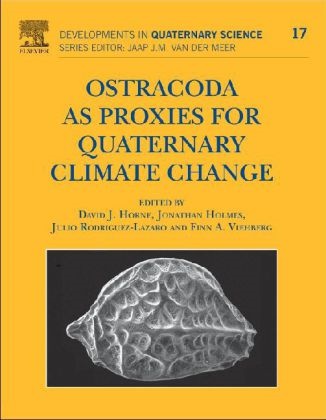En savoir plus
Klappentext This volume is a combination of up-to-date reviews covering previous work and summarizing the state of art, with presentations of new, cutting-edge science (data and interpretations as well as methodological developments) to form a major reference work that will constitute a durable benchmark in the science of ostracoda and quaternary climate change. Zusammenfassung As methods of using ostracods as Quaternary palaeoclimate proxies have developed! so too has a critical awareness of their complexities! potential and limitations. This book combines reviews with presentations of science to form a reference work that can constitute a durable bench-mark in science of Ostracoda and Quaternary climate change. Inhaltsverzeichnis Part 1. Introduction to Quaternary and living ostracods 1. A general introduction to ostracods: morphology, distribution, fossil record and applications 2. The ecology of Ostracoda across levels of biological organisation from individual to ecosystem: a review of recent developments and future potential Part 2. Ostracods as palaeoclimate proxies: ecological and biogeographical approaches 3. Ostracod taxa as palaeoclimate indicators in the Quaternary 4. Quantitative transfer function approaches in palaeoclimatic reconstruction using Quaternary ostracods 5. Mutual climatic range methods for Quaternary ostracods 6.The biogeography and physicochemical characteristics of aquatic habitats of freshwater ostracods in Canada and the United States 7. Distribution of freshwater ostracods in the Canadian North and implications for palaeoclimate reconstructions Part 3. Ostracods as palaeoclimate proxies: geochemical approaches 8. The chemical composition of ostracod shells: applications in Quaternary palaeoclimatology 9. The calibration of environmental controls on trace element ratios in ostracod shell calcite: A critical assessment 10. Biological and environmental controls on isotopes in ostracod shells Part 4. Multi-proxy approaches to Quaternary palaeoclimate studies 11. The versatility of Quaternary ostracods as palaeoclimate proxies: comparative testing of geochemical and ecological/biogeographical approaches 12. Ostracods as indicators of climatic and human-influenced changes in the Late Quaternary of the Ponto-Caspian region (Aral, Caspian and Black seas) 13. Geochemical and palaeoecological analyses of Mid Pleistocene to Holocene ostracod assemblages from Valle di Castiglione (Italy): palaeoenvironmental and palaeoclimatic assessment 14. Climate Variability during the Medieval Climate Anomaly and Little Ice Age based on ostracod faunas and shell geochemistry from Biscayne Bay, Florida 15. Quaternary ostracods from the Tibetan Plateau and their significance for environmental and climate-change studies 16. Holocene lake level changes of Lake Nam Co, Tibetan Plateau, deduced from ostracod assemblages and ?O and ?C signatures of their valves Part 5. Future development: potential and limitations of ostracods in Quaternary palaeoclimatology 17. Palaeogenetics for ostracods (Crustacea, Ostracoda) 18. Ostracoda as proxies for Quaternary climate change: overview and future prospects ...
Table des matières
Part 1. Introduction to Quaternary and living ostracods
1. A general introduction to ostracods: morphology, distribution, fossil record and applications
2. The ecology of Ostracoda across levels of biological organisation from individual to ecosystem: a review of recent developments and future potential
Part 2. Ostracods as palaeoclimate proxies: ecological and biogeographical approaches
3. Ostracod taxa as palaeoclimate indicators in the Quaternary
4. Quantitative transfer function approaches in palaeoclimatic reconstruction using Quaternary ostracods
5. Mutual climatic range methods for Quaternary ostracods
6.The biogeography and physicochemical characteristics of aquatic habitats of freshwater ostracods in Canada and the United States
7. Distribution of freshwater ostracods in the Canadian North and implications for palaeoclimate reconstructions
Part 3. Ostracods as palaeoclimate proxies: geochemical approaches
8. The chemical composition of ostracod shells: applications in Quaternary palaeoclimatology
9. The calibration of environmental controls on trace element ratios in ostracod shell calcite: A critical assessment
10. Biological and environmental controls on isotopes in ostracod shells
Part 4. Multi-proxy approaches to Quaternary palaeoclimate studies
11. The versatility of Quaternary ostracods as palaeoclimate proxies: comparative testing of geochemical and ecological/biogeographical approaches
12. Ostracods as indicators of climatic and human-influenced changes in the Late Quaternary of the Ponto-Caspian region (Aral, Caspian and Black seas)
13. Geochemical and palaeoecological analyses of Mid Pleistocene to Holocene ostracod assemblages from Valle di Castiglione (Italy): palaeoenvironmental and palaeoclimatic assessment
14. Climate Variability during the Medieval Climate Anomaly and Little Ice Age based on ostracod faunas and shell geochemistry from Biscayne Bay, Florida
15. Quaternary ostracods from the Tibetan Plateau and their significance for environmental and climate-change studies
16. Holocene lake level changes of Lake Nam Co, Tibetan Plateau, deduced from ostracod assemblages and ?18O and ?13C signatures of their valves
Part 5. Future development: potential and limitations of ostracods in Quaternary palaeoclimatology
17. Palaeogenetics for ostracods (Crustacea, Ostracoda)
18. Ostracoda as proxies for Quaternary climate change: overview and future prospects

